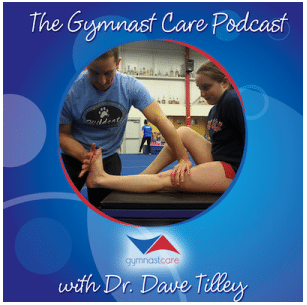A Complete Guide to Elbow OCD In Gymnasts – What It Is and Treatment
Today on the Shift Show I deep dive Elbow OCD (Osteochondritis Dissecans a condition that affects gymnasts and baseball players.
It is a cartilage injury that occurs in the elbow joint and can cause pain, swelling, and stiffness.
Unfortunately, there is not a lot of great research on how to treat this condition, leaving many athletes feeling overwhelmed and frustrated.
In this episode, I discuss what elbow OCD is, why it happens, and the treatment options available to those who suffer from it.
What is Elbow OCD?
Elbow OCD is a condition that affects the elbow joint. It is a cartilage injury that occurs when a small piece of bone and cartilage breaks off in the joint. This can cause pain, swelling, and stiffness in the affected joint. Elbow OCD is commonly seen in gymnasts and baseball players due to the repetitive nature of their sports.
Why Does Elbow OCD Happen?
The exact cause of elbow OCD is not known, but it is believed to be related to repetitive stress on the joint. In gymnasts, this stress can come from doing too many repetitive motions such as handstands, cartwheels, and vaults. In baseball players, it can come from throwing too many pitches or playing too many games.
Treatment Options for Elbow OCD
The treatment for elbow OCD depends on the severity of the injury. In some cases, conservative treatment such as rest, ice, and physical therapy can help. In other cases, surgery may be necessary.
Conservative Treatment
Conservative treatment for elbow OCD involves rest and physical therapy. Resting the affected joint can help reduce pain and swelling. Physical therapy can also help strengthen the muscles around the joint, which can help reduce the risk of further injury.
Physical therapy exercises for elbow OCD may include:
- Range of motion exercises to help improve flexibility
- Strengthening exercises for the muscles around the elbow joint
- Balance and coordination exercises
- Neuromuscular re-education exercises to help the athlete learn how to move the joint in a way that reduces stress on the joint
Surgical Treatment
In some cases, surgery may be necessary to treat elbow OCD. The type of surgery needed will depend on the severity of the injury. The most common type of surgery for elbow OCD is called arthroscopic surgery. During this procedure, a small camera is inserted into the joint to help the surgeon see the damage. The surgeon will then remove the damaged tissue and bone from the joint.
Recovery from Elbow OCD Surgery
Recovery from elbow OCD surgery can take several months. The athlete will need to wear a brace or cast for several weeks after the surgery to protect the joint. Physical therapy will also be necessary to help the athlete regain strength and mobility in the joint. The physical therapist will work with the athlete to create a rehabilitation program that is tailored to their specific needs.
Elbow OCD is a condition that can be very challenging for gymnasts and other athletes. However, with the right treatment, it is possible to overcome this injury and return to sports.
Conservative treatment such as rest and physical therapy can be effective for some athletes, while others may require surgery.
If you are struggling with elbow OCD, it is important to seek help from a qualified medical professional who can guide you through the treatment process.
I Discuss:
- What is a repetitive overuse injury?
- How does OCD develop over time?
- What do you do if you have OCD?
- How to mitigate the risk of repetitive overuse injuries.
- Hybrid strength and conditioning.
- A study on elbow loading.
- Early warning signs of elbow pain.
- How does it take to return to sport? And…
- Surgical Treatment for OCD.
A Complete Guide to Elbow OCD In Gymnasts – What It Is and Treatment
Mourad F, Maselli F, Patuzzo A, Siracusa A, Di Filippo L, Dunning J, de Las Peñas CF. OSTEOCHONDRITIS DISSECANS OF THE RADIAL HEAD IN A YOUNG ATHLETE: A CASE REPORT. Int J Sports Phys Ther. 2018 Aug;13(4):726-736. PMID: 30140566; PMCID: PMC6088130.
https://pubmed.ncbi.nlm.nih.gov/30140566/ (https://pubmed.ncbi.nlm.nih.gov/30140566/)
Logli AL, Bernard CD, O’Driscoll SW, Sanchez-Sotelo J, Morrey ME, Krych AJ, Camp CL. Osteochondritis dissecans lesions of the capitellum in overhead athletes: a review of current evidence and proposed treatment algorithm. Curr Rev Musculoskelet Med. 2019 Mar;12(1):1-12. doi: 10.1007/s12178-019-09528-8. PMID: 30645727; PMCID: PMC6388572.
https://pubmed.ncbi.nlm.nih.gov/30645727/ (https://pubmed.ncbi.nlm.nih.gov/30645727/)
Mourad F, Maselli F, Patuzzo A, Siracusa A, Di Filippo L, Dunning J, de Las Peñas CF. OSTEOCHONDRITIS DISSECANS OF THE RADIAL HEAD IN A YOUNG ATHLETE: A CASE REPORT. Int J Sports Phys Ther. 2018 Aug;13(4):726-736. PMID: 30140566; PMCID: PMC6088130.
Bruns J, Werner M, Habermann CR. Osteochondritis Dissecans of Smaller Joints: The Elbow. Cartilage. 2021 Oct;12(4):407-417. doi: 10.1177/1947603519847735. Epub 2019 May 21. PMID: 31113206; PMCID: PMC8461164.
Kajiyama S, Muroi S, Sugaya H, Takahashi N, Matsuki K, Kawai N, Osaki M. Osteochondritis Dissecans of the Humeral Capitellum in Young Athletes: Comparison Between Baseball Players and Gymnasts. Orthop J Sports Med. 2017 Mar 1;5(3):2325967117692513. doi: 10.1177/2325967117692513. PMID: 28321431; PMCID: PMC5347432.
https://pubmed.ncbi.nlm.nih.gov/28321431/ (https://pubmed.ncbi.nlm.nih.gov/28321431/)
Bae DS, Ingall EM, Miller PE, Eisenberg K. Early Results of S
ingle-plug Autologous Osteochondral Grafting for Osteochondritis Dissecans of the Capitellum in Adolescents. J Pediatr Orthop. 2020 Feb;40(2):78-85. doi: 10.1097/BPO.0000000000001114. PMID: 31923167.
https://pubmed.ncbi.nlm.nih.gov/31923167/ (https://pubmed.ncbi.nlm.nih.gov/31923167/)
Farana R, Irwin G, Jandacka D, Uchytil J, Mullineaux DR. Elbow joint variability for different hand positions of the round off in gymnastics. Hum Mov Sci. 2015 Feb;39:88-100. doi: 10.1016/j.humov.2014.11.001. Epub 2014 Nov 25. PMID: 25461436.
https://pubmed.ncbi.nlm.nih.gov/25461436/
I hope it helps!
– Dave
Dr. Dave Tilley DPT, SCS, CSCS
CEO/Founder of SHIFT Movement Science












